Strategic Analysis of Marriott International in the Hospitality Sector
VerifiedAdded on 2023/05/15
|19
|4816
|232
Report
AI Summary
This report provides a comprehensive strategic analysis of Marriott International, a global leader in the hospitality industry. It begins with an introduction to Marriott's mission, vision, and objectives, followed by an overview of strategic planning techniques and frameworks, including benchmarking, business analysis, and stakeholder analysis. The report applies the PESTLE analysis to assess the macro environment, examining political, economic, social, technological, legal, and environmental factors influencing Marriott's operations. It then evaluates the internal environment using the VRIO framework to assess resources and capabilities, followed by a SWOT analysis to identify strengths, weaknesses, opportunities, and threats. The report also discusses the benefits and drawbacks of the PESTLE and Porter's Five Forces models, providing insights into strategic management decisions. Overall, the analysis aims to inform strategic decisions and enhance Marriott's competitive position in the global hospitality market.
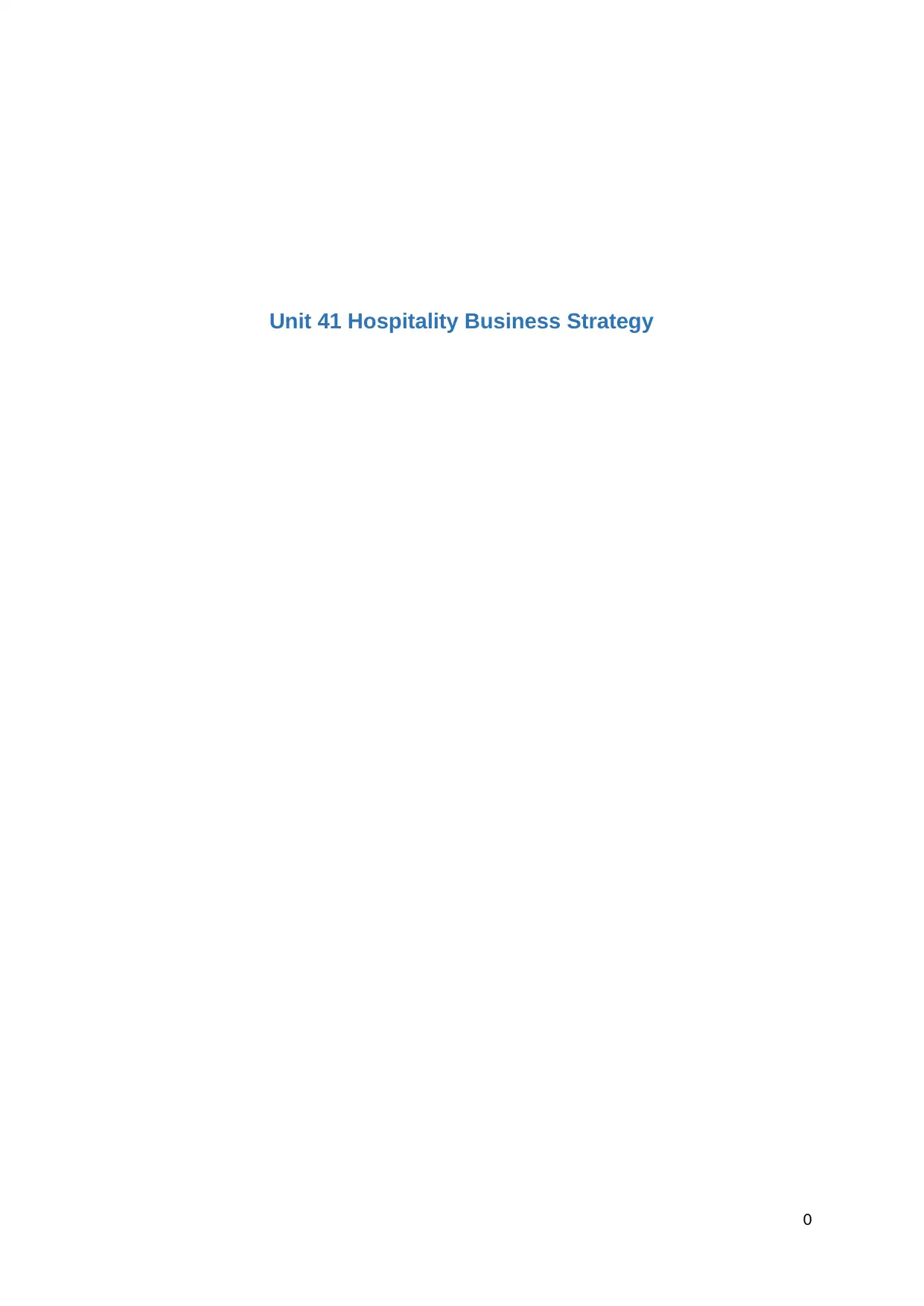
Unit 41 Hospitality Business Strategy
0
0
Paraphrase This Document
Need a fresh take? Get an instant paraphrase of this document with our AI Paraphraser
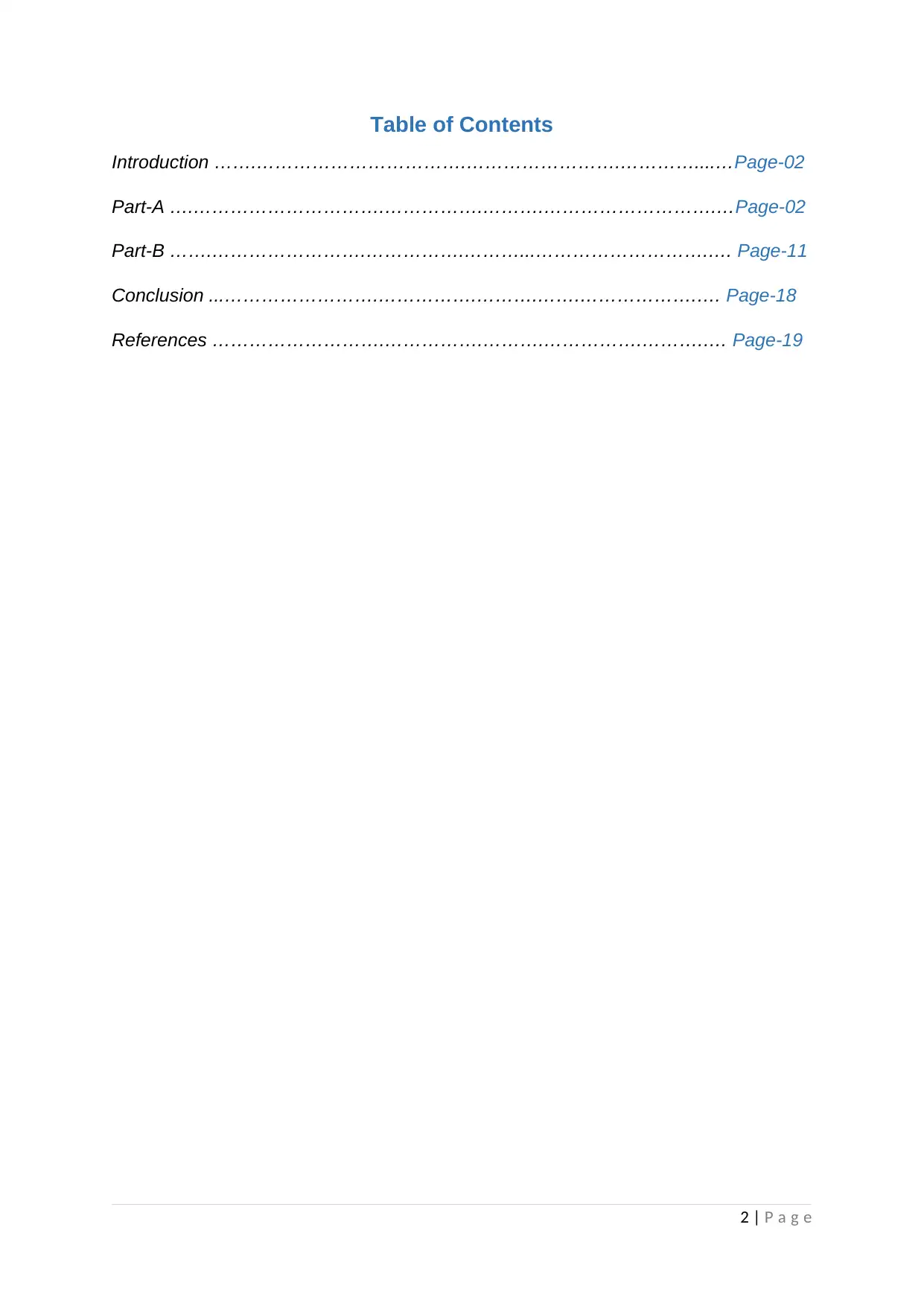
Table of Contents
Introduction …….…………………………….…………………….…………....…Page-02
Part-A ….………………………….…………….……….……………………….…Page-02
Part-B …….…………………….…………….………...……………………….…. Page-11
Conclusion ...…………………….…………….……….…….……………….…. Page-18
References ……………………….…………….……….…………….……….…. Page-19
2 | P a g e
Introduction …….…………………………….…………………….…………....…Page-02
Part-A ….………………………….…………….……….……………………….…Page-02
Part-B …….…………………….…………….………...……………………….…. Page-11
Conclusion ...…………………….…………….……….…….……………….…. Page-18
References ……………………….…………….……….…………….……….…. Page-19
2 | P a g e
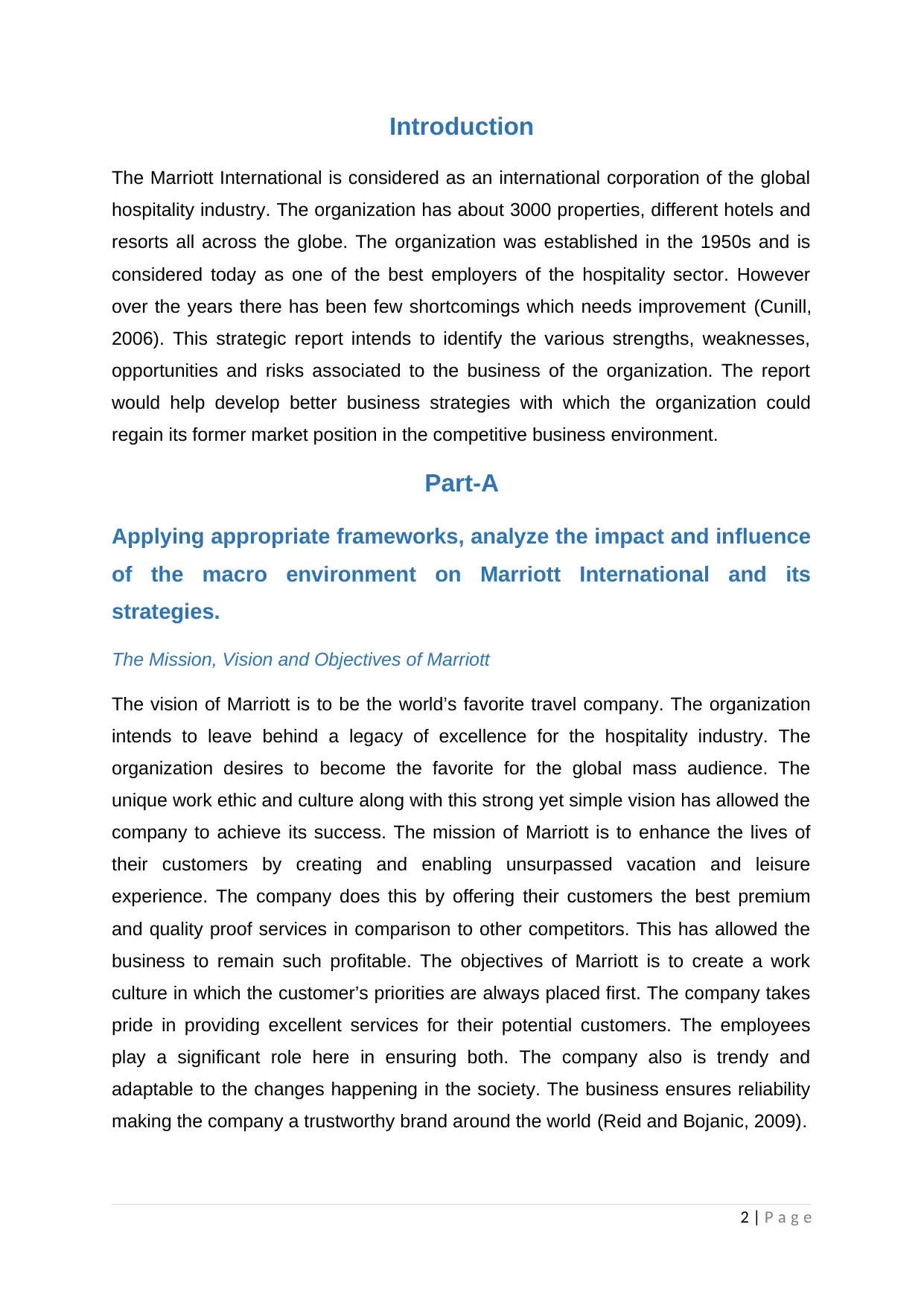
Introduction
The Marriott International is considered as an international corporation of the global
hospitality industry. The organization has about 3000 properties, different hotels and
resorts all across the globe. The organization was established in the 1950s and is
considered today as one of the best employers of the hospitality sector. However
over the years there has been few shortcomings which needs improvement (Cunill,
2006). This strategic report intends to identify the various strengths, weaknesses,
opportunities and risks associated to the business of the organization. The report
would help develop better business strategies with which the organization could
regain its former market position in the competitive business environment.
Part-A
Applying appropriate frameworks, analyze the impact and influence
of the macro environment on Marriott International and its
strategies.
The Mission, Vision and Objectives of Marriott
The vision of Marriott is to be the world’s favorite travel company. The organization
intends to leave behind a legacy of excellence for the hospitality industry. The
organization desires to become the favorite for the global mass audience. The
unique work ethic and culture along with this strong yet simple vision has allowed the
company to achieve its success. The mission of Marriott is to enhance the lives of
their customers by creating and enabling unsurpassed vacation and leisure
experience. The company does this by offering their customers the best premium
and quality proof services in comparison to other competitors. This has allowed the
business to remain such profitable. The objectives of Marriott is to create a work
culture in which the customer’s priorities are always placed first. The company takes
pride in providing excellent services for their potential customers. The employees
play a significant role here in ensuring both. The company also is trendy and
adaptable to the changes happening in the society. The business ensures reliability
making the company a trustworthy brand around the world (Reid and Bojanic, 2009).
2 | P a g e
The Marriott International is considered as an international corporation of the global
hospitality industry. The organization has about 3000 properties, different hotels and
resorts all across the globe. The organization was established in the 1950s and is
considered today as one of the best employers of the hospitality sector. However
over the years there has been few shortcomings which needs improvement (Cunill,
2006). This strategic report intends to identify the various strengths, weaknesses,
opportunities and risks associated to the business of the organization. The report
would help develop better business strategies with which the organization could
regain its former market position in the competitive business environment.
Part-A
Applying appropriate frameworks, analyze the impact and influence
of the macro environment on Marriott International and its
strategies.
The Mission, Vision and Objectives of Marriott
The vision of Marriott is to be the world’s favorite travel company. The organization
intends to leave behind a legacy of excellence for the hospitality industry. The
organization desires to become the favorite for the global mass audience. The
unique work ethic and culture along with this strong yet simple vision has allowed the
company to achieve its success. The mission of Marriott is to enhance the lives of
their customers by creating and enabling unsurpassed vacation and leisure
experience. The company does this by offering their customers the best premium
and quality proof services in comparison to other competitors. This has allowed the
business to remain such profitable. The objectives of Marriott is to create a work
culture in which the customer’s priorities are always placed first. The company takes
pride in providing excellent services for their potential customers. The employees
play a significant role here in ensuring both. The company also is trendy and
adaptable to the changes happening in the society. The business ensures reliability
making the company a trustworthy brand around the world (Reid and Bojanic, 2009).
2 | P a g e
⊘ This is a preview!⊘
Do you want full access?
Subscribe today to unlock all pages.

Trusted by 1+ million students worldwide
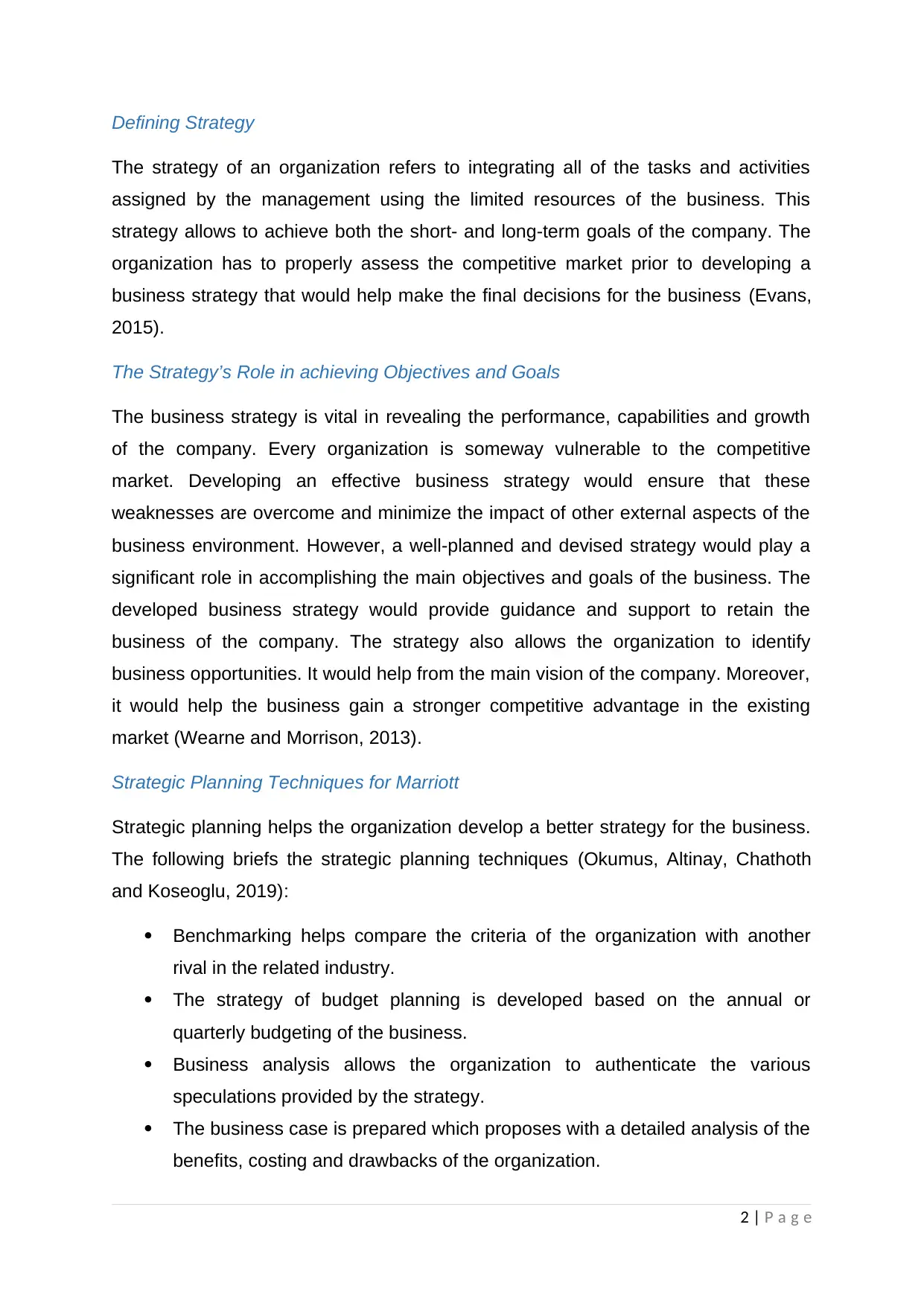
Defining Strategy
The strategy of an organization refers to integrating all of the tasks and activities
assigned by the management using the limited resources of the business. This
strategy allows to achieve both the short- and long-term goals of the company. The
organization has to properly assess the competitive market prior to developing a
business strategy that would help make the final decisions for the business (Evans,
2015).
The Strategy’s Role in achieving Objectives and Goals
The business strategy is vital in revealing the performance, capabilities and growth
of the company. Every organization is someway vulnerable to the competitive
market. Developing an effective business strategy would ensure that these
weaknesses are overcome and minimize the impact of other external aspects of the
business environment. However, a well-planned and devised strategy would play a
significant role in accomplishing the main objectives and goals of the business. The
developed business strategy would provide guidance and support to retain the
business of the company. The strategy also allows the organization to identify
business opportunities. It would help from the main vision of the company. Moreover,
it would help the business gain a stronger competitive advantage in the existing
market (Wearne and Morrison, 2013).
Strategic Planning Techniques for Marriott
Strategic planning helps the organization develop a better strategy for the business.
The following briefs the strategic planning techniques (Okumus, Altinay, Chathoth
and Koseoglu, 2019):
Benchmarking helps compare the criteria of the organization with another
rival in the related industry.
The strategy of budget planning is developed based on the annual or
quarterly budgeting of the business.
Business analysis allows the organization to authenticate the various
speculations provided by the strategy.
The business case is prepared which proposes with a detailed analysis of the
benefits, costing and drawbacks of the organization.
2 | P a g e
The strategy of an organization refers to integrating all of the tasks and activities
assigned by the management using the limited resources of the business. This
strategy allows to achieve both the short- and long-term goals of the company. The
organization has to properly assess the competitive market prior to developing a
business strategy that would help make the final decisions for the business (Evans,
2015).
The Strategy’s Role in achieving Objectives and Goals
The business strategy is vital in revealing the performance, capabilities and growth
of the company. Every organization is someway vulnerable to the competitive
market. Developing an effective business strategy would ensure that these
weaknesses are overcome and minimize the impact of other external aspects of the
business environment. However, a well-planned and devised strategy would play a
significant role in accomplishing the main objectives and goals of the business. The
developed business strategy would provide guidance and support to retain the
business of the company. The strategy also allows the organization to identify
business opportunities. It would help from the main vision of the company. Moreover,
it would help the business gain a stronger competitive advantage in the existing
market (Wearne and Morrison, 2013).
Strategic Planning Techniques for Marriott
Strategic planning helps the organization develop a better strategy for the business.
The following briefs the strategic planning techniques (Okumus, Altinay, Chathoth
and Koseoglu, 2019):
Benchmarking helps compare the criteria of the organization with another
rival in the related industry.
The strategy of budget planning is developed based on the annual or
quarterly budgeting of the business.
Business analysis allows the organization to authenticate the various
speculations provided by the strategy.
The business case is prepared which proposes with a detailed analysis of the
benefits, costing and drawbacks of the organization.
2 | P a g e
Paraphrase This Document
Need a fresh take? Get an instant paraphrase of this document with our AI Paraphraser
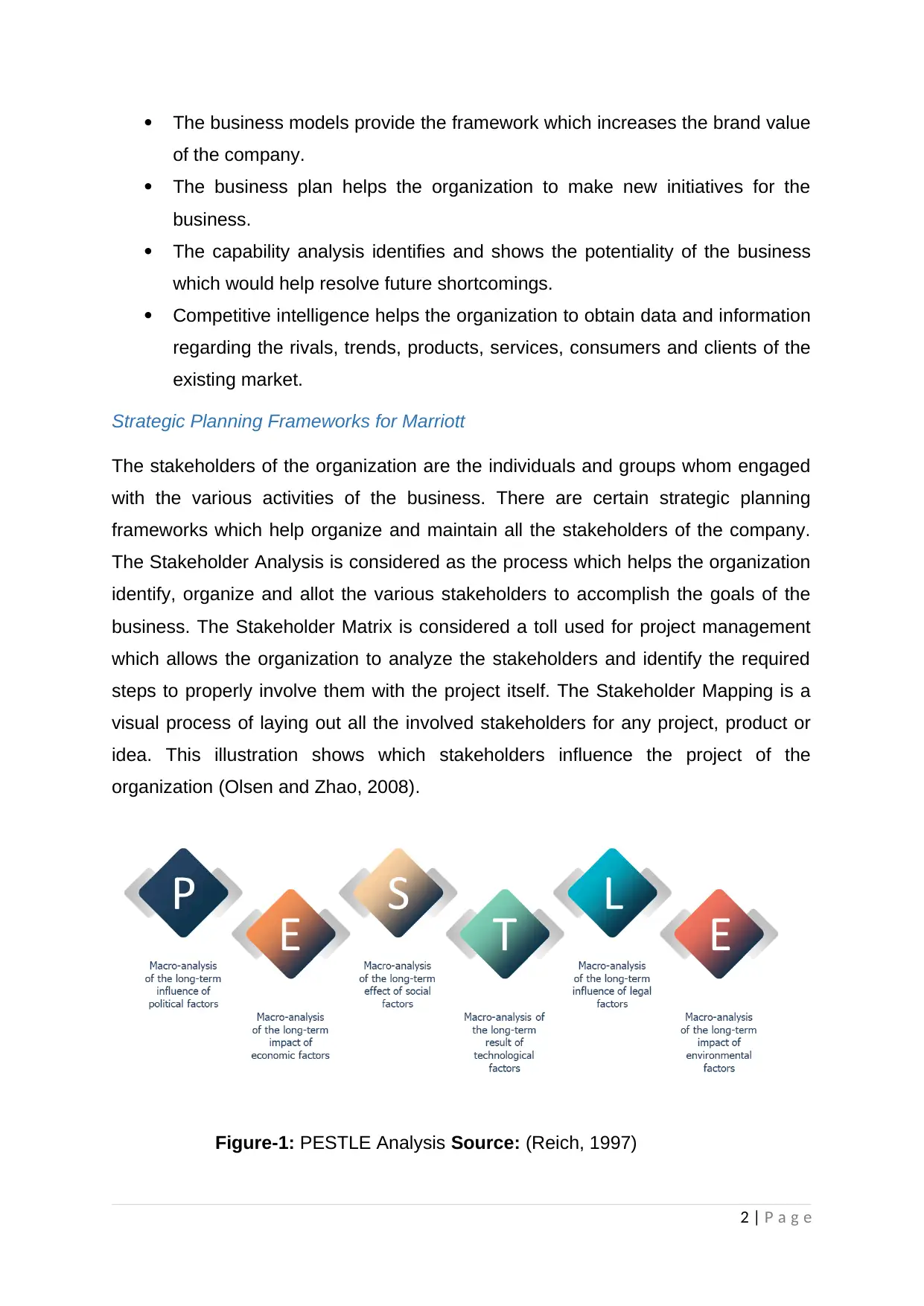
The business models provide the framework which increases the brand value
of the company.
The business plan helps the organization to make new initiatives for the
business.
The capability analysis identifies and shows the potentiality of the business
which would help resolve future shortcomings.
Competitive intelligence helps the organization to obtain data and information
regarding the rivals, trends, products, services, consumers and clients of the
existing market.
Strategic Planning Frameworks for Marriott
The stakeholders of the organization are the individuals and groups whom engaged
with the various activities of the business. There are certain strategic planning
frameworks which help organize and maintain all the stakeholders of the company.
The Stakeholder Analysis is considered as the process which helps the organization
identify, organize and allot the various stakeholders to accomplish the goals of the
business. The Stakeholder Matrix is considered a toll used for project management
which allows the organization to analyze the stakeholders and identify the required
steps to properly involve them with the project itself. The Stakeholder Mapping is a
visual process of laying out all the involved stakeholders for any project, product or
idea. This illustration shows which stakeholders influence the project of the
organization (Olsen and Zhao, 2008).
Figure-1: PESTLE Analysis Source: (Reich, 1997)
2 | P a g e
of the company.
The business plan helps the organization to make new initiatives for the
business.
The capability analysis identifies and shows the potentiality of the business
which would help resolve future shortcomings.
Competitive intelligence helps the organization to obtain data and information
regarding the rivals, trends, products, services, consumers and clients of the
existing market.
Strategic Planning Frameworks for Marriott
The stakeholders of the organization are the individuals and groups whom engaged
with the various activities of the business. There are certain strategic planning
frameworks which help organize and maintain all the stakeholders of the company.
The Stakeholder Analysis is considered as the process which helps the organization
identify, organize and allot the various stakeholders to accomplish the goals of the
business. The Stakeholder Matrix is considered a toll used for project management
which allows the organization to analyze the stakeholders and identify the required
steps to properly involve them with the project itself. The Stakeholder Mapping is a
visual process of laying out all the involved stakeholders for any project, product or
idea. This illustration shows which stakeholders influence the project of the
organization (Olsen and Zhao, 2008).
Figure-1: PESTLE Analysis Source: (Reich, 1997)
2 | P a g e
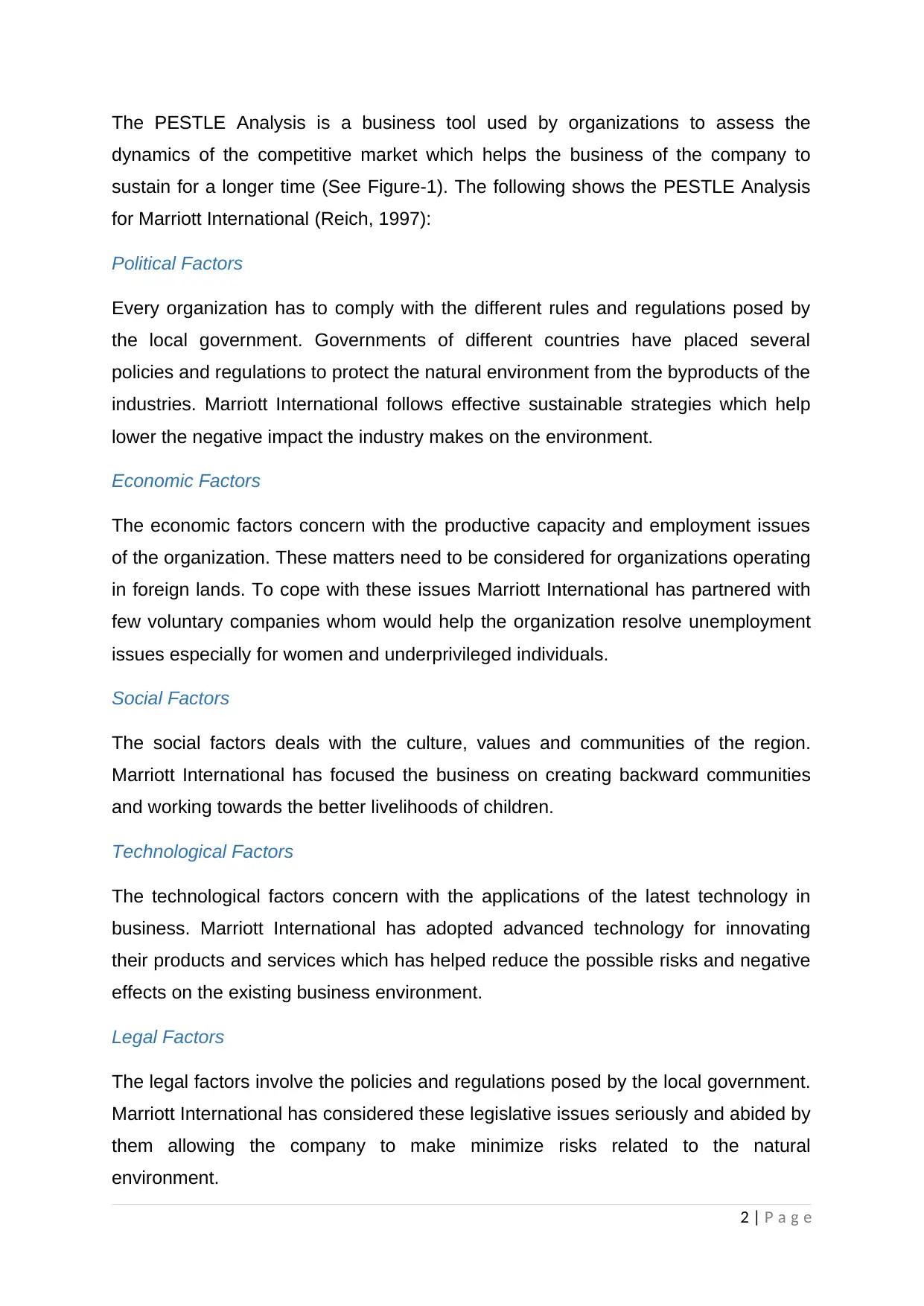
The PESTLE Analysis is a business tool used by organizations to assess the
dynamics of the competitive market which helps the business of the company to
sustain for a longer time (See Figure-1). The following shows the PESTLE Analysis
for Marriott International (Reich, 1997):
Political Factors
Every organization has to comply with the different rules and regulations posed by
the local government. Governments of different countries have placed several
policies and regulations to protect the natural environment from the byproducts of the
industries. Marriott International follows effective sustainable strategies which help
lower the negative impact the industry makes on the environment.
Economic Factors
The economic factors concern with the productive capacity and employment issues
of the organization. These matters need to be considered for organizations operating
in foreign lands. To cope with these issues Marriott International has partnered with
few voluntary companies whom would help the organization resolve unemployment
issues especially for women and underprivileged individuals.
Social Factors
The social factors deals with the culture, values and communities of the region.
Marriott International has focused the business on creating backward communities
and working towards the better livelihoods of children.
Technological Factors
The technological factors concern with the applications of the latest technology in
business. Marriott International has adopted advanced technology for innovating
their products and services which has helped reduce the possible risks and negative
effects on the existing business environment.
Legal Factors
The legal factors involve the policies and regulations posed by the local government.
Marriott International has considered these legislative issues seriously and abided by
them allowing the company to make minimize risks related to the natural
environment.
2 | P a g e
dynamics of the competitive market which helps the business of the company to
sustain for a longer time (See Figure-1). The following shows the PESTLE Analysis
for Marriott International (Reich, 1997):
Political Factors
Every organization has to comply with the different rules and regulations posed by
the local government. Governments of different countries have placed several
policies and regulations to protect the natural environment from the byproducts of the
industries. Marriott International follows effective sustainable strategies which help
lower the negative impact the industry makes on the environment.
Economic Factors
The economic factors concern with the productive capacity and employment issues
of the organization. These matters need to be considered for organizations operating
in foreign lands. To cope with these issues Marriott International has partnered with
few voluntary companies whom would help the organization resolve unemployment
issues especially for women and underprivileged individuals.
Social Factors
The social factors deals with the culture, values and communities of the region.
Marriott International has focused the business on creating backward communities
and working towards the better livelihoods of children.
Technological Factors
The technological factors concern with the applications of the latest technology in
business. Marriott International has adopted advanced technology for innovating
their products and services which has helped reduce the possible risks and negative
effects on the existing business environment.
Legal Factors
The legal factors involve the policies and regulations posed by the local government.
Marriott International has considered these legislative issues seriously and abided by
them allowing the company to make minimize risks related to the natural
environment.
2 | P a g e
⊘ This is a preview!⊘
Do you want full access?
Subscribe today to unlock all pages.

Trusted by 1+ million students worldwide
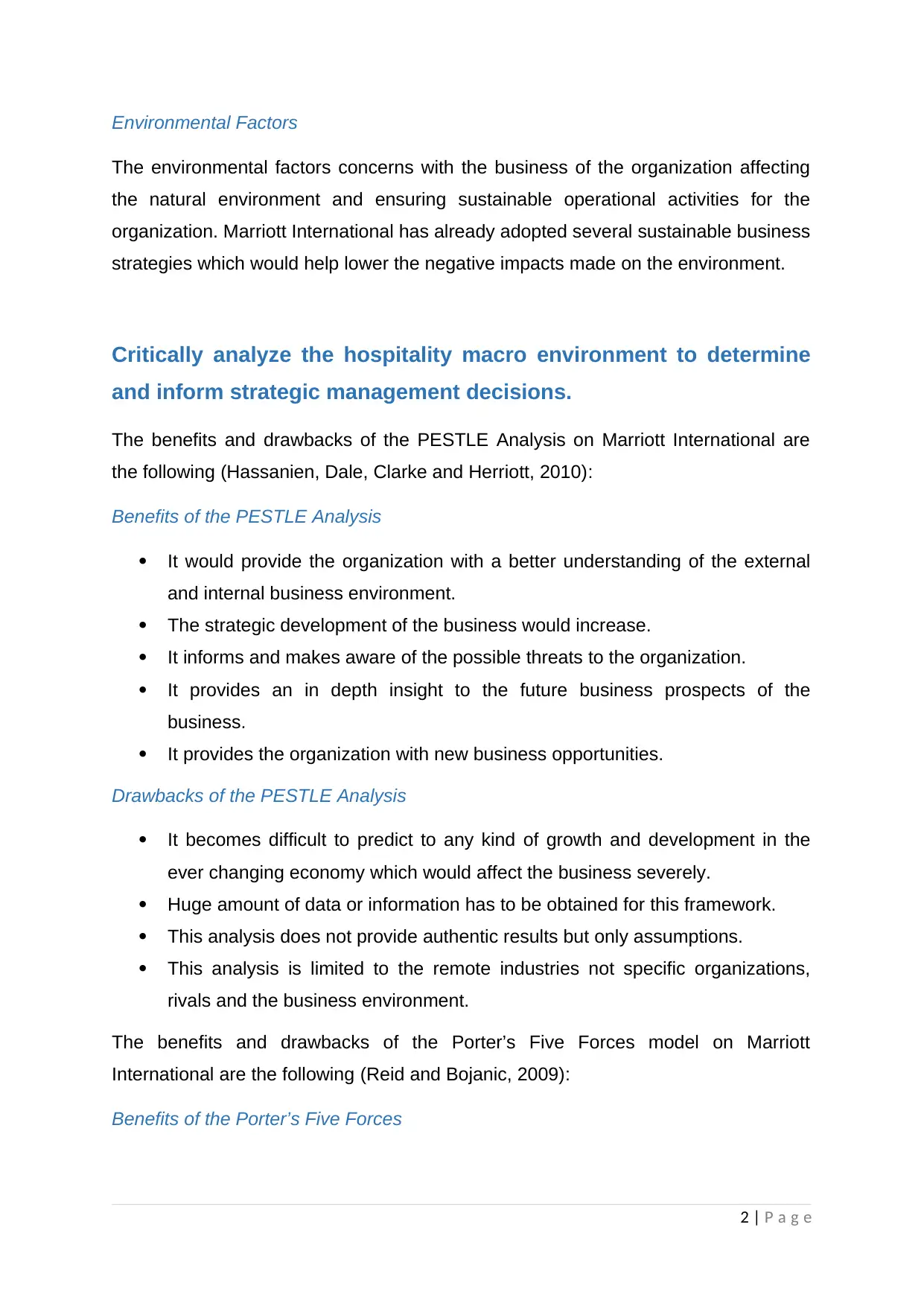
Environmental Factors
The environmental factors concerns with the business of the organization affecting
the natural environment and ensuring sustainable operational activities for the
organization. Marriott International has already adopted several sustainable business
strategies which would help lower the negative impacts made on the environment.
Critically analyze the hospitality macro environment to determine
and inform strategic management decisions.
The benefits and drawbacks of the PESTLE Analysis on Marriott International are
the following (Hassanien, Dale, Clarke and Herriott, 2010):
Benefits of the PESTLE Analysis
It would provide the organization with a better understanding of the external
and internal business environment.
The strategic development of the business would increase.
It informs and makes aware of the possible threats to the organization.
It provides an in depth insight to the future business prospects of the
business.
It provides the organization with new business opportunities.
Drawbacks of the PESTLE Analysis
It becomes difficult to predict to any kind of growth and development in the
ever changing economy which would affect the business severely.
Huge amount of data or information has to be obtained for this framework.
This analysis does not provide authentic results but only assumptions.
This analysis is limited to the remote industries not specific organizations,
rivals and the business environment.
The benefits and drawbacks of the Porter’s Five Forces model on Marriott
International are the following (Reid and Bojanic, 2009):
Benefits of the Porter’s Five Forces
2 | P a g e
The environmental factors concerns with the business of the organization affecting
the natural environment and ensuring sustainable operational activities for the
organization. Marriott International has already adopted several sustainable business
strategies which would help lower the negative impacts made on the environment.
Critically analyze the hospitality macro environment to determine
and inform strategic management decisions.
The benefits and drawbacks of the PESTLE Analysis on Marriott International are
the following (Hassanien, Dale, Clarke and Herriott, 2010):
Benefits of the PESTLE Analysis
It would provide the organization with a better understanding of the external
and internal business environment.
The strategic development of the business would increase.
It informs and makes aware of the possible threats to the organization.
It provides an in depth insight to the future business prospects of the
business.
It provides the organization with new business opportunities.
Drawbacks of the PESTLE Analysis
It becomes difficult to predict to any kind of growth and development in the
ever changing economy which would affect the business severely.
Huge amount of data or information has to be obtained for this framework.
This analysis does not provide authentic results but only assumptions.
This analysis is limited to the remote industries not specific organizations,
rivals and the business environment.
The benefits and drawbacks of the Porter’s Five Forces model on Marriott
International are the following (Reid and Bojanic, 2009):
Benefits of the Porter’s Five Forces
2 | P a g e
Paraphrase This Document
Need a fresh take? Get an instant paraphrase of this document with our AI Paraphraser
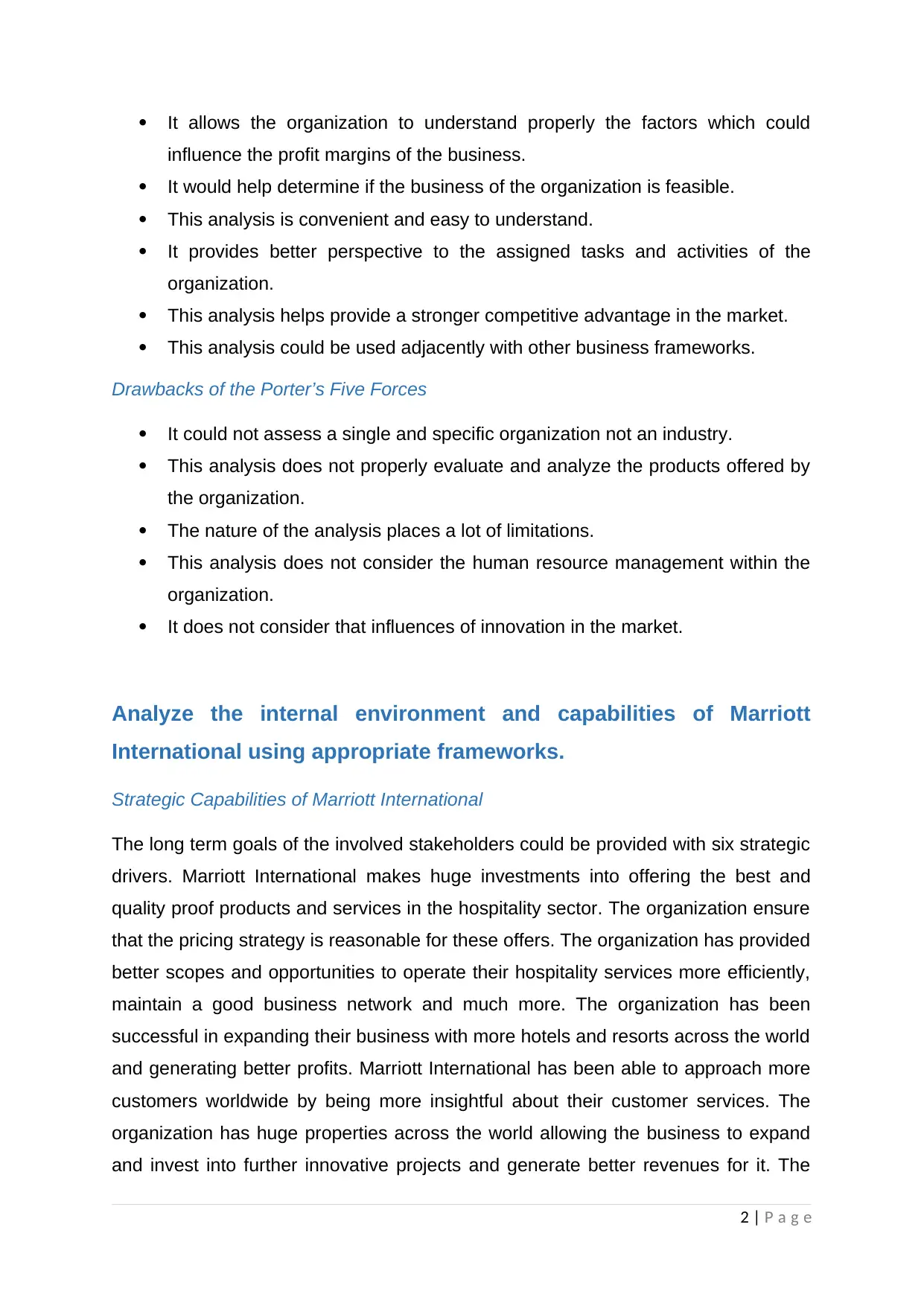
It allows the organization to understand properly the factors which could
influence the profit margins of the business.
It would help determine if the business of the organization is feasible.
This analysis is convenient and easy to understand.
It provides better perspective to the assigned tasks and activities of the
organization.
This analysis helps provide a stronger competitive advantage in the market.
This analysis could be used adjacently with other business frameworks.
Drawbacks of the Porter’s Five Forces
It could not assess a single and specific organization not an industry.
This analysis does not properly evaluate and analyze the products offered by
the organization.
The nature of the analysis places a lot of limitations.
This analysis does not consider the human resource management within the
organization.
It does not consider that influences of innovation in the market.
Analyze the internal environment and capabilities of Marriott
International using appropriate frameworks.
Strategic Capabilities of Marriott International
The long term goals of the involved stakeholders could be provided with six strategic
drivers. Marriott International makes huge investments into offering the best and
quality proof products and services in the hospitality sector. The organization ensure
that the pricing strategy is reasonable for these offers. The organization has provided
better scopes and opportunities to operate their hospitality services more efficiently,
maintain a good business network and much more. The organization has been
successful in expanding their business with more hotels and resorts across the world
and generating better profits. Marriott International has been able to approach more
customers worldwide by being more insightful about their customer services. The
organization has huge properties across the world allowing the business to expand
and invest into further innovative projects and generate better revenues for it. The
2 | P a g e
influence the profit margins of the business.
It would help determine if the business of the organization is feasible.
This analysis is convenient and easy to understand.
It provides better perspective to the assigned tasks and activities of the
organization.
This analysis helps provide a stronger competitive advantage in the market.
This analysis could be used adjacently with other business frameworks.
Drawbacks of the Porter’s Five Forces
It could not assess a single and specific organization not an industry.
This analysis does not properly evaluate and analyze the products offered by
the organization.
The nature of the analysis places a lot of limitations.
This analysis does not consider the human resource management within the
organization.
It does not consider that influences of innovation in the market.
Analyze the internal environment and capabilities of Marriott
International using appropriate frameworks.
Strategic Capabilities of Marriott International
The long term goals of the involved stakeholders could be provided with six strategic
drivers. Marriott International makes huge investments into offering the best and
quality proof products and services in the hospitality sector. The organization ensure
that the pricing strategy is reasonable for these offers. The organization has provided
better scopes and opportunities to operate their hospitality services more efficiently,
maintain a good business network and much more. The organization has been
successful in expanding their business with more hotels and resorts across the world
and generating better profits. Marriott International has been able to approach more
customers worldwide by being more insightful about their customer services. The
organization has huge properties across the world allowing the business to expand
and invest into further innovative projects and generate better revenues for it. The
2 | P a g e
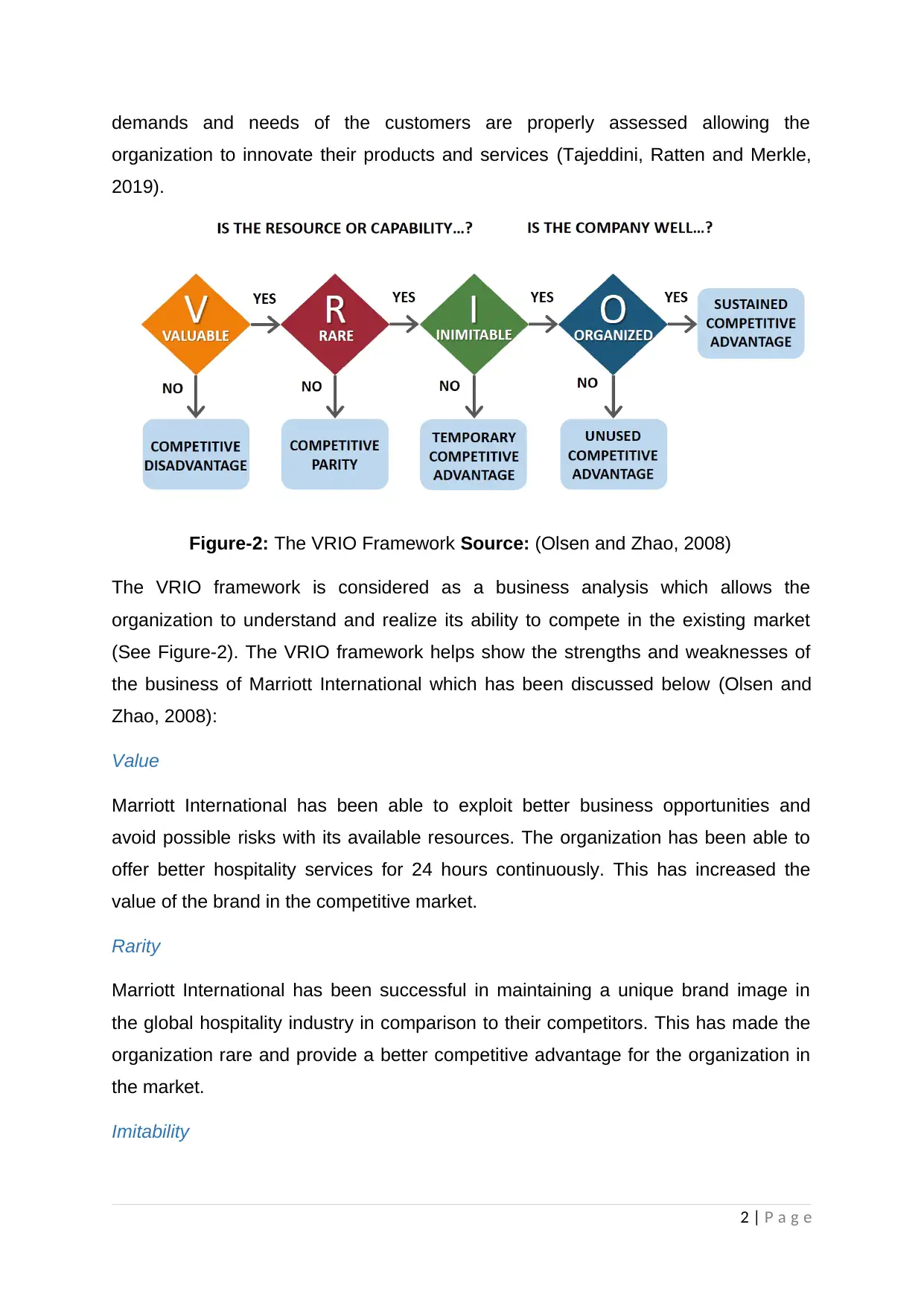
demands and needs of the customers are properly assessed allowing the
organization to innovate their products and services (Tajeddini, Ratten and Merkle,
2019).
Figure-2: The VRIO Framework Source: (Olsen and Zhao, 2008)
The VRIO framework is considered as a business analysis which allows the
organization to understand and realize its ability to compete in the existing market
(See Figure-2). The VRIO framework helps show the strengths and weaknesses of
the business of Marriott International which has been discussed below (Olsen and
Zhao, 2008):
Value
Marriott International has been able to exploit better business opportunities and
avoid possible risks with its available resources. The organization has been able to
offer better hospitality services for 24 hours continuously. This has increased the
value of the brand in the competitive market.
Rarity
Marriott International has been successful in maintaining a unique brand image in
the global hospitality industry in comparison to their competitors. This has made the
organization rare and provide a better competitive advantage for the organization in
the market.
Imitability
2 | P a g e
organization to innovate their products and services (Tajeddini, Ratten and Merkle,
2019).
Figure-2: The VRIO Framework Source: (Olsen and Zhao, 2008)
The VRIO framework is considered as a business analysis which allows the
organization to understand and realize its ability to compete in the existing market
(See Figure-2). The VRIO framework helps show the strengths and weaknesses of
the business of Marriott International which has been discussed below (Olsen and
Zhao, 2008):
Value
Marriott International has been able to exploit better business opportunities and
avoid possible risks with its available resources. The organization has been able to
offer better hospitality services for 24 hours continuously. This has increased the
value of the brand in the competitive market.
Rarity
Marriott International has been successful in maintaining a unique brand image in
the global hospitality industry in comparison to their competitors. This has made the
organization rare and provide a better competitive advantage for the organization in
the market.
Imitability
2 | P a g e
⊘ This is a preview!⊘
Do you want full access?
Subscribe today to unlock all pages.

Trusted by 1+ million students worldwide
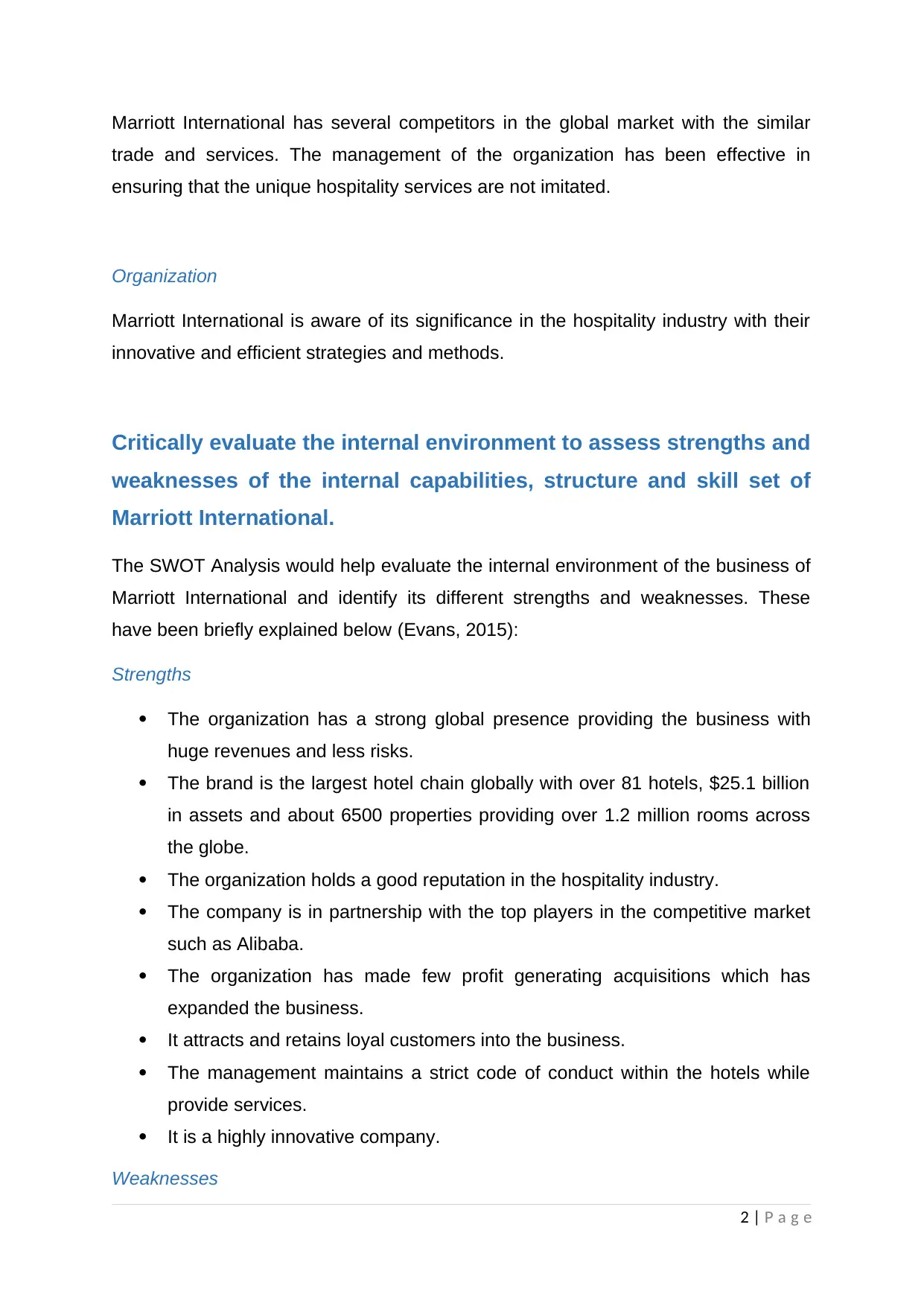
Marriott International has several competitors in the global market with the similar
trade and services. The management of the organization has been effective in
ensuring that the unique hospitality services are not imitated.
Organization
Marriott International is aware of its significance in the hospitality industry with their
innovative and efficient strategies and methods.
Critically evaluate the internal environment to assess strengths and
weaknesses of the internal capabilities, structure and skill set of
Marriott International.
The SWOT Analysis would help evaluate the internal environment of the business of
Marriott International and identify its different strengths and weaknesses. These
have been briefly explained below (Evans, 2015):
Strengths
The organization has a strong global presence providing the business with
huge revenues and less risks.
The brand is the largest hotel chain globally with over 81 hotels, $25.1 billion
in assets and about 6500 properties providing over 1.2 million rooms across
the globe.
The organization holds a good reputation in the hospitality industry.
The company is in partnership with the top players in the competitive market
such as Alibaba.
The organization has made few profit generating acquisitions which has
expanded the business.
It attracts and retains loyal customers into the business.
The management maintains a strict code of conduct within the hotels while
provide services.
It is a highly innovative company.
Weaknesses
2 | P a g e
trade and services. The management of the organization has been effective in
ensuring that the unique hospitality services are not imitated.
Organization
Marriott International is aware of its significance in the hospitality industry with their
innovative and efficient strategies and methods.
Critically evaluate the internal environment to assess strengths and
weaknesses of the internal capabilities, structure and skill set of
Marriott International.
The SWOT Analysis would help evaluate the internal environment of the business of
Marriott International and identify its different strengths and weaknesses. These
have been briefly explained below (Evans, 2015):
Strengths
The organization has a strong global presence providing the business with
huge revenues and less risks.
The brand is the largest hotel chain globally with over 81 hotels, $25.1 billion
in assets and about 6500 properties providing over 1.2 million rooms across
the globe.
The organization holds a good reputation in the hospitality industry.
The company is in partnership with the top players in the competitive market
such as Alibaba.
The organization has made few profit generating acquisitions which has
expanded the business.
It attracts and retains loyal customers into the business.
The management maintains a strict code of conduct within the hotels while
provide services.
It is a highly innovative company.
Weaknesses
2 | P a g e
Paraphrase This Document
Need a fresh take? Get an instant paraphrase of this document with our AI Paraphraser
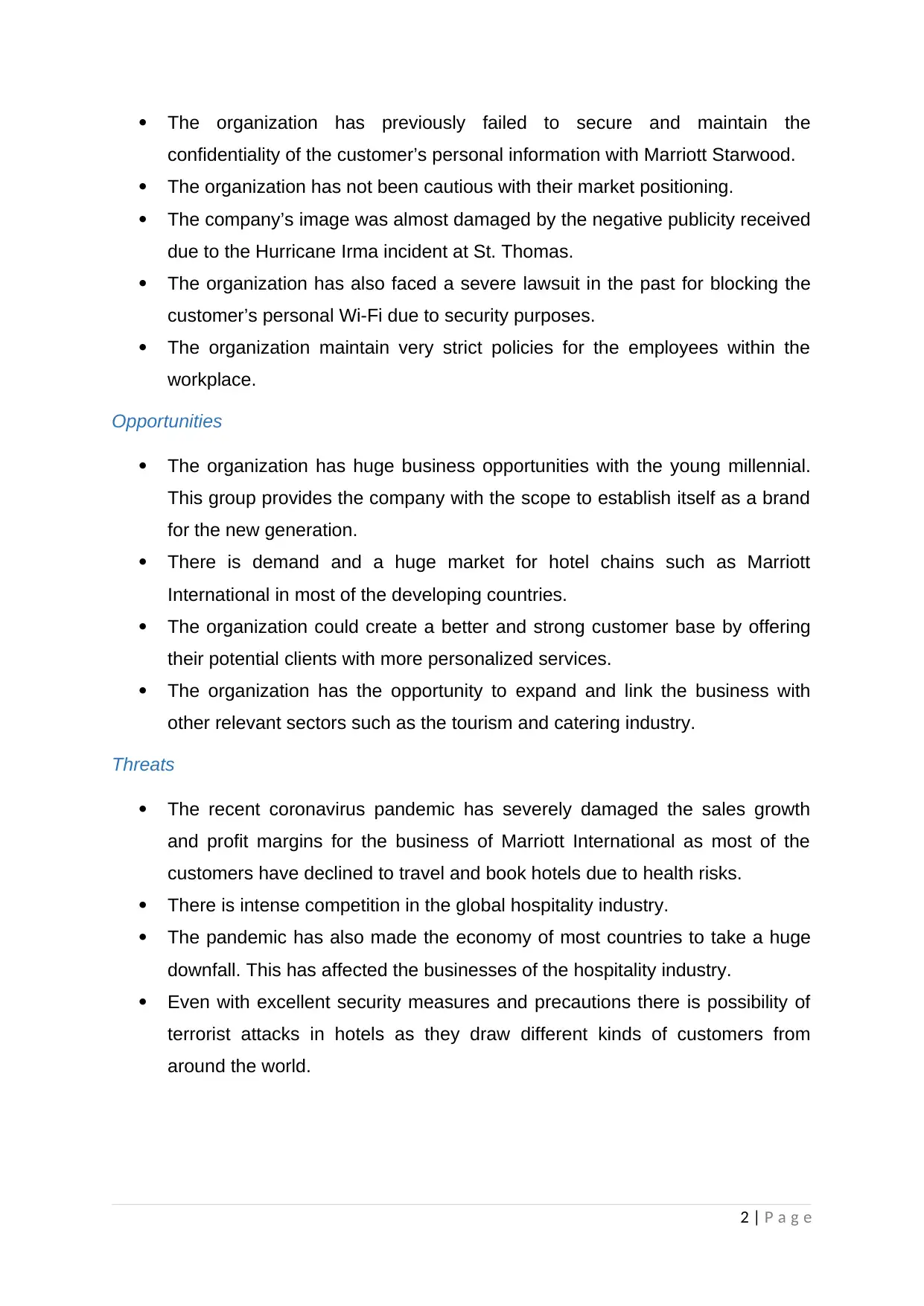
The organization has previously failed to secure and maintain the
confidentiality of the customer’s personal information with Marriott Starwood.
The organization has not been cautious with their market positioning.
The company’s image was almost damaged by the negative publicity received
due to the Hurricane Irma incident at St. Thomas.
The organization has also faced a severe lawsuit in the past for blocking the
customer’s personal Wi-Fi due to security purposes.
The organization maintain very strict policies for the employees within the
workplace.
Opportunities
The organization has huge business opportunities with the young millennial.
This group provides the company with the scope to establish itself as a brand
for the new generation.
There is demand and a huge market for hotel chains such as Marriott
International in most of the developing countries.
The organization could create a better and strong customer base by offering
their potential clients with more personalized services.
The organization has the opportunity to expand and link the business with
other relevant sectors such as the tourism and catering industry.
Threats
The recent coronavirus pandemic has severely damaged the sales growth
and profit margins for the business of Marriott International as most of the
customers have declined to travel and book hotels due to health risks.
There is intense competition in the global hospitality industry.
The pandemic has also made the economy of most countries to take a huge
downfall. This has affected the businesses of the hospitality industry.
Even with excellent security measures and precautions there is possibility of
terrorist attacks in hotels as they draw different kinds of customers from
around the world.
2 | P a g e
confidentiality of the customer’s personal information with Marriott Starwood.
The organization has not been cautious with their market positioning.
The company’s image was almost damaged by the negative publicity received
due to the Hurricane Irma incident at St. Thomas.
The organization has also faced a severe lawsuit in the past for blocking the
customer’s personal Wi-Fi due to security purposes.
The organization maintain very strict policies for the employees within the
workplace.
Opportunities
The organization has huge business opportunities with the young millennial.
This group provides the company with the scope to establish itself as a brand
for the new generation.
There is demand and a huge market for hotel chains such as Marriott
International in most of the developing countries.
The organization could create a better and strong customer base by offering
their potential clients with more personalized services.
The organization has the opportunity to expand and link the business with
other relevant sectors such as the tourism and catering industry.
Threats
The recent coronavirus pandemic has severely damaged the sales growth
and profit margins for the business of Marriott International as most of the
customers have declined to travel and book hotels due to health risks.
There is intense competition in the global hospitality industry.
The pandemic has also made the economy of most countries to take a huge
downfall. This has affected the businesses of the hospitality industry.
Even with excellent security measures and precautions there is possibility of
terrorist attacks in hotels as they draw different kinds of customers from
around the world.
2 | P a g e
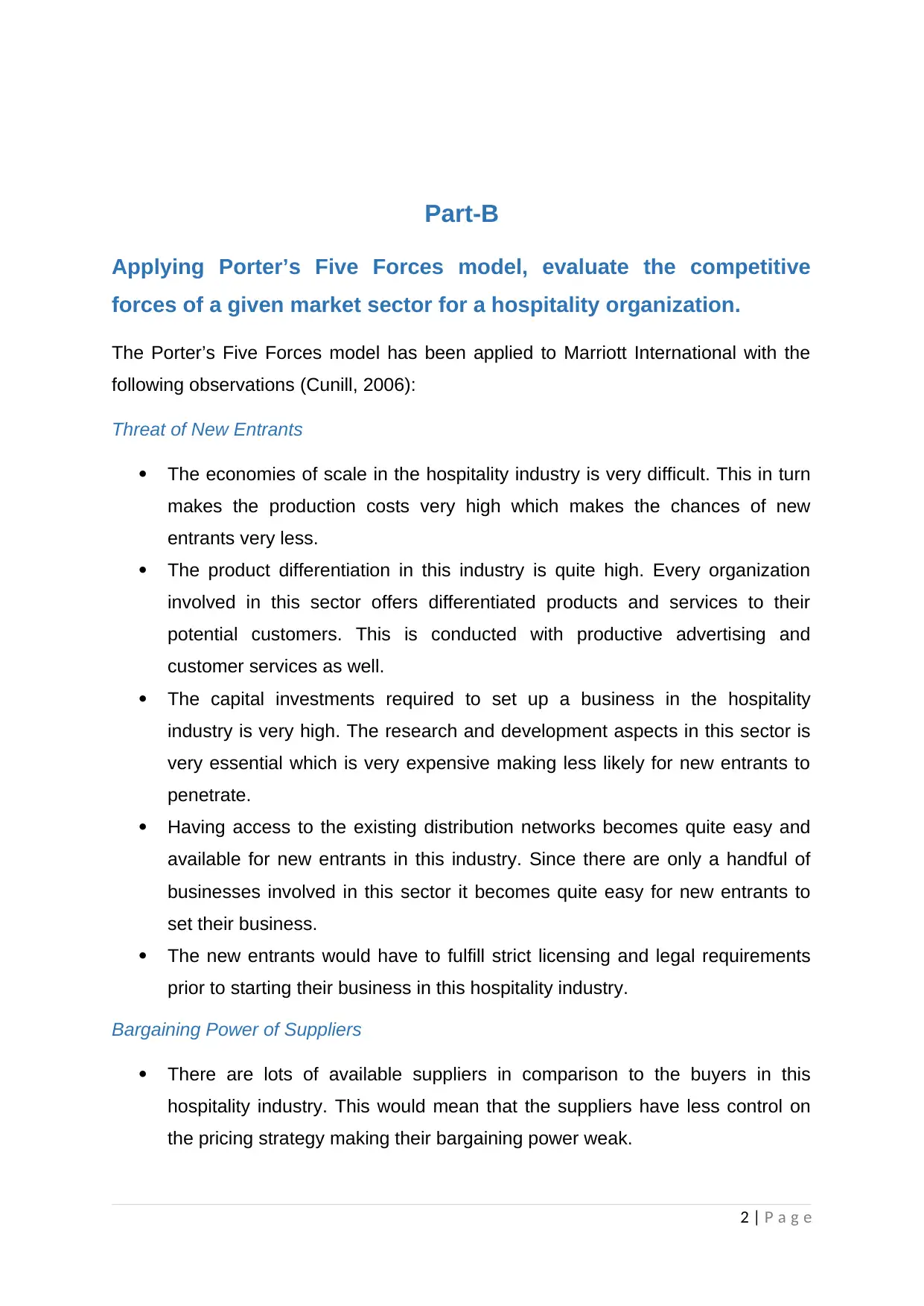
Part-B
Applying Porter’s Five Forces model, evaluate the competitive
forces of a given market sector for a hospitality organization.
The Porter’s Five Forces model has been applied to Marriott International with the
following observations (Cunill, 2006):
Threat of New Entrants
The economies of scale in the hospitality industry is very difficult. This in turn
makes the production costs very high which makes the chances of new
entrants very less.
The product differentiation in this industry is quite high. Every organization
involved in this sector offers differentiated products and services to their
potential customers. This is conducted with productive advertising and
customer services as well.
The capital investments required to set up a business in the hospitality
industry is very high. The research and development aspects in this sector is
very essential which is very expensive making less likely for new entrants to
penetrate.
Having access to the existing distribution networks becomes quite easy and
available for new entrants in this industry. Since there are only a handful of
businesses involved in this sector it becomes quite easy for new entrants to
set their business.
The new entrants would have to fulfill strict licensing and legal requirements
prior to starting their business in this hospitality industry.
Bargaining Power of Suppliers
There are lots of available suppliers in comparison to the buyers in this
hospitality industry. This would mean that the suppliers have less control on
the pricing strategy making their bargaining power weak.
2 | P a g e
Applying Porter’s Five Forces model, evaluate the competitive
forces of a given market sector for a hospitality organization.
The Porter’s Five Forces model has been applied to Marriott International with the
following observations (Cunill, 2006):
Threat of New Entrants
The economies of scale in the hospitality industry is very difficult. This in turn
makes the production costs very high which makes the chances of new
entrants very less.
The product differentiation in this industry is quite high. Every organization
involved in this sector offers differentiated products and services to their
potential customers. This is conducted with productive advertising and
customer services as well.
The capital investments required to set up a business in the hospitality
industry is very high. The research and development aspects in this sector is
very essential which is very expensive making less likely for new entrants to
penetrate.
Having access to the existing distribution networks becomes quite easy and
available for new entrants in this industry. Since there are only a handful of
businesses involved in this sector it becomes quite easy for new entrants to
set their business.
The new entrants would have to fulfill strict licensing and legal requirements
prior to starting their business in this hospitality industry.
Bargaining Power of Suppliers
There are lots of available suppliers in comparison to the buyers in this
hospitality industry. This would mean that the suppliers have less control on
the pricing strategy making their bargaining power weak.
2 | P a g e
⊘ This is a preview!⊘
Do you want full access?
Subscribe today to unlock all pages.

Trusted by 1+ million students worldwide
1 out of 19
Related Documents
Your All-in-One AI-Powered Toolkit for Academic Success.
+13062052269
info@desklib.com
Available 24*7 on WhatsApp / Email
![[object Object]](/_next/static/media/star-bottom.7253800d.svg)
Unlock your academic potential
Copyright © 2020–2025 A2Z Services. All Rights Reserved. Developed and managed by ZUCOL.





